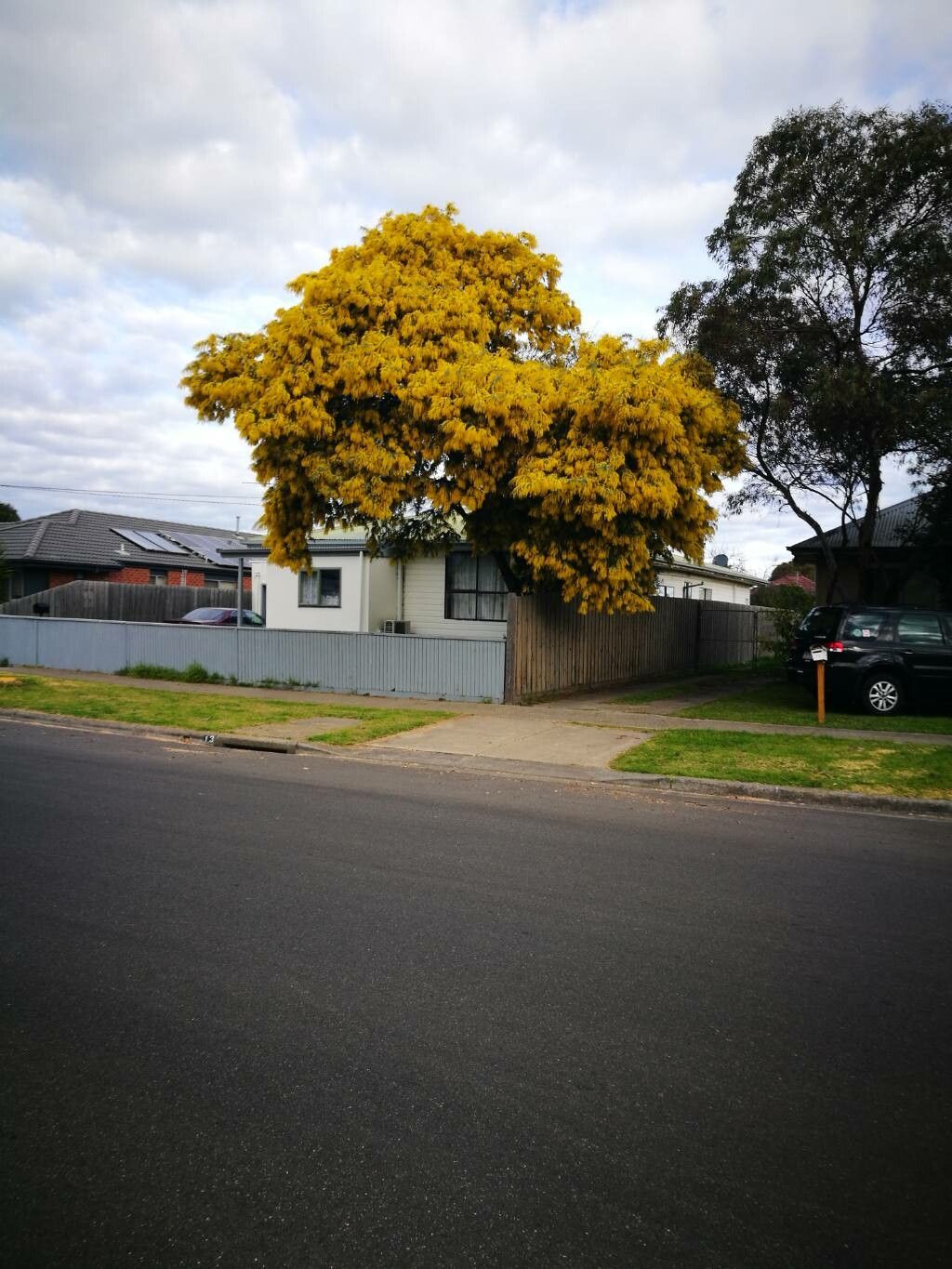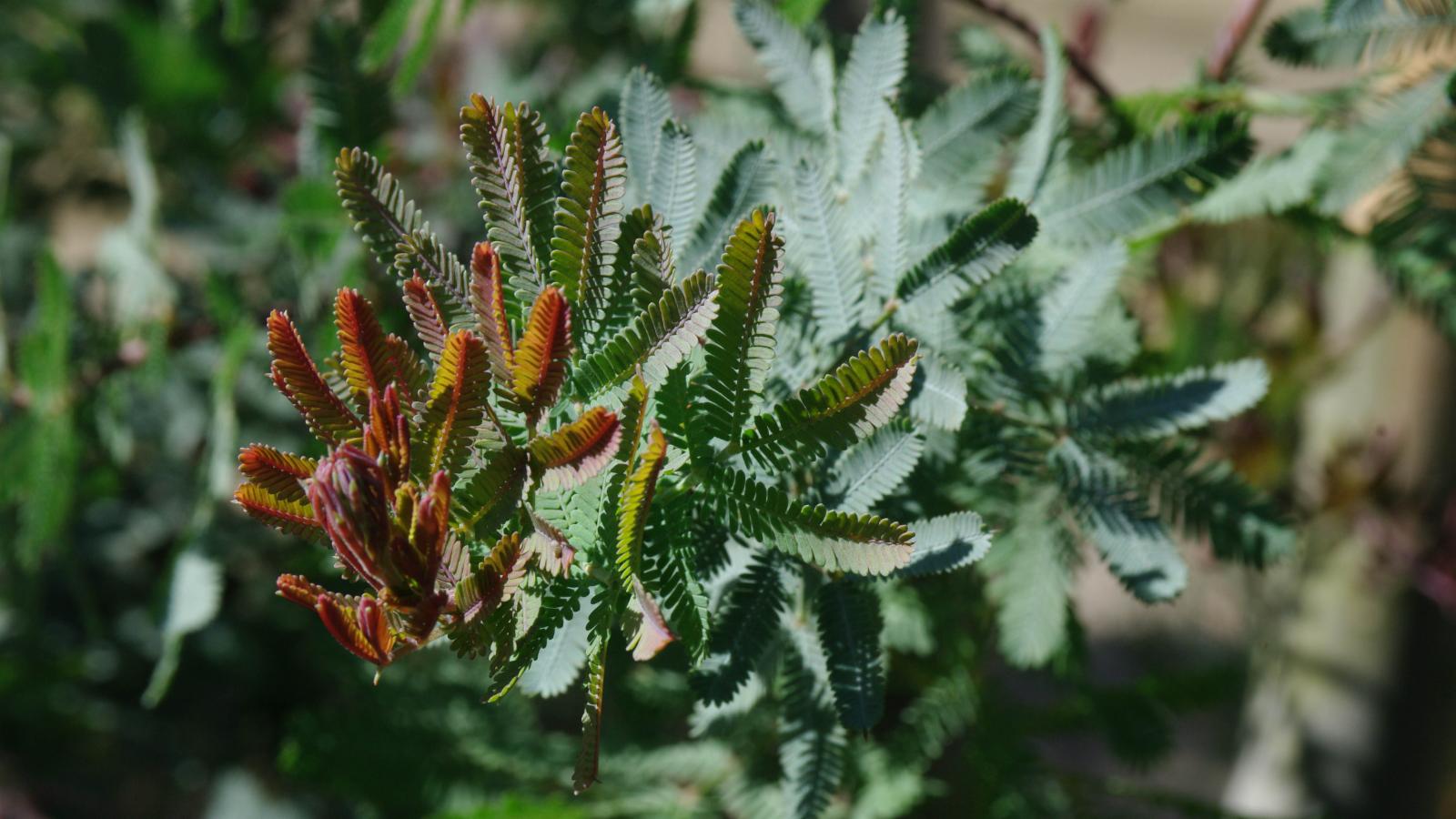Cootamundra Wattle
acacia baileyana
Also known as: ["Cootamundra Wattle","Bailey's Wattle"]
Overview
A fast-growing, deciduous tree native to Australia, known for its vibrant yellow flowers and feathery foliage.
Benefits & Perks
["long-flowering","wildlife attractant (bees, butterflies, birds)","drought tolerant","fast growing"]
Botanical Classification
| Phylum: | Magnoliophyta |
| Class: | Magnoliopsida |
| Order: | Fabales |
| Family: | Fabaceae |
| Genus: | Acacia |
| Botanical Name: | Acacia baileyana |
Plant Characteristics
Basic Information
- Category: Trees
- Suitable Location: outdoor garden in a sunny spot, or large container in a sheltered area
- Suitable For:
- Is Weed: No
- Allergenicity: low
Environmental Needs
- Climate: {"temperatureRange":"5–35°C"}
- Hardiness: {"zones":"8–10"}
- Misting: rarely required, only if ambient humidity is very low
- Drainage: Fast-draining to prevent root rot.
- Soil Type: Well-draining, sandy loam with some organic matter. Avoid heavy clay soils.
Maintenance Level
- Maintenance Level: moderate
- Toughness Level: high
- Pruning Frequency: Annually, after flowering, or as needed to remove dead/diseased branches.
- Pruning Intensity: Moderate. Remove up to one-third of old growth to rejuvenate the plant.
Care Details
Ideal Sunlight Coverage:
Full sun (6–8 hours of direct sunlight daily). Tolerates partial shade but may become leggy with insufficient light.
Sunlight Tolerance Tips:
Acclimate plants gradually to intense sunlight to avoid scorching. Protect from harsh afternoon sun in hot climates. Indoors, place near a south-facing window.
Care Requirements
Care Difficulty
moderatemoderate
Sunlight
full sun to partial shade
Rotate plant for even light exposure; use sheer curtains to filter intense sun; monitor for signs of sunburn.
Watering
every 7–10 days during active growth, reduce in winter
Water thoroughly but infrequently; allow soil to dry between waterings; avoid overwatering to prevent root rot.
Soil
well-drained, sandy or loamy soil
pH: Slightly acidic to neutral (pH 6.0–7.0).
Ensure soil dries between waterings; amend heavy soils with sand or perlite; test pH periodically.
Temperature
Prefers mild temperatures (60–75°F or 15–24°C). Tolerates light frosts but is sensitive to prolonged cold or extreme heat.
Avoid sudden temperature changes; protect from frost; provide shade during extreme heat.
Fertilizing
every 2–3 months during spring and summer
Fertilize only during active growth; avoid over-fertilizing to prevent salt buildup; flush soil occasionally to remove excess salts.
Propagation
Methods
Stem cuttings or seed. Stem cuttings are more reliable for cloning specific traits.
Step-by-Step Propagation Guide
- Take 4–6 inch cuttings.
- Remove lower leaves.
- Dip in rooting hormone.
- Plant in medium.
- Maintain humidity.
- Wait for roots.
Best Time: Late spring or early summer when the plant is actively growing.
Environment
Warm (70–75°F or 21–24°C), humid, and bright but indirect light. Protect from direct sun and drafts.
Medium
Well-draining mix of perlite and peat moss, or cactus/succulent potting mix.
Hormone
Recommended to use rooting hormone for faster and more reliable rooting.
Timeline
Roots may develop in 4–8 weeks. Transplant once roots are well-established (3–6 months).
Tools Needed
Pruning shears, rooting hormone, small pots, well-draining medium, plastic wrap or propagator.
Quick Tips
Use healthy, non-flowering stems; maintain high humidity; avoid overwatering cuttings.
Pruning & Repotting
Pruning Guide
Method
Selective thinning of branches to improve air circulation and light penetration. Avoid heavy shearing.
Pruning Plan
Prune to maintain shape, encourage bushiness, and remove dead or diseased wood. Pruning also stimulates flowering.
Tools
Pruning shears, loppers, gloves, disinfectant for tools.
Checklist
Disinfect tools; prune after flowering; remove dead/diseased wood; shape lightly; avoid over-pruning.
Repotting Guide
Best Season
Early spring, before the active growth period begins.
Pot Size
Increase pot size by 2–3 inches in diameter. Avoid oversized pots to prevent waterlogging.
Method
Remove plant gently; trim any circling roots; place in a slightly larger pot with fresh, well-draining soil; water thoroughly.
Suggestions
Repot every 2–3 years or when roots fill the pot. Acacia baileyana prefers slightly root-bound conditions but benefits from fresh soil.
Checklist
Choose appropriate pot size; use fresh soil mix; trim roots if needed; water after repotting; place in appropriate light.
Advanced Care Tips
Watering Mastery
Watering Checklist
Check soil moisture before watering; water deeply; ensure drainage; avoid wetting foliage.
How to Apply Water Properly
Water at the base of the plant, ensuring moisture reaches the root zone. Water early in the morning to minimize evaporation and allow foliage to dry. Ensure excess water drains away to prevent waterlogging.
Watering Schedule Tips
Water deeply once a week during spring and summer, reducing frequency to every 2–3 weeks in fall and winter. Adjust based on rainfall and soil moisture.
Soil Improvement
Add perlite or coarse sand to improve drainage. Incorporate compost for organic matter and fertility.
Temperature Stress Management
Signs of Temperature Issues
Chlorosis (yellowing leaves), leaf drop, stunted growth, or browning leaf tips.
Cold Stress
Low temperatures slow growth and may cause leaf drop or dieback. Prolonged cold can damage roots and lead to plant death.
Solution: Protect from frost with frost cloth or mulch. Move potted plants indoors during freezes. Ensure good drainage to prevent cold root damage.
Hot Stress
Excessive heat can cause wilting, leaf scorch, or reduced flowering. Heat stress may lead to dehydration and nutrient uptake issues.
Solution: Provide afternoon shade in hot climates. Water deeply during heatwaves. Use mulch to retain soil moisture and cool roots.
Fertilizing Guide
Fertilizing Checklist
Use balanced fertilizer; apply in spring; avoid winter feeding; monitor for salt buildup.
Fertilizing Method
Use a balanced, slow-release fertilizer in spring. Dilute liquid fertilizer to half-strength if needed. Avoid fertilizing in late fall or winter.
Common Problems & Solutions
Toxicity Warning
Cats
Slightly ToxicCats are sensitive to cyanogenic glycosides, which can lead to gastrointestinal irritation and potential systemic effects if ingested in significant amounts.
⚠️ Symptoms:
🌿 Toxic Parts:
⚡ Toxic If:
if eaten
Dogs
Slightly ToxicThe cyanogenic glycosides in Acacia baileyana can cause mild to moderate gastrointestinal upset in dogs. Systemic toxicity is rare but possible with large ingestions.
⚠️ Symptoms:
🌿 Toxic Parts:
⚡ Toxic If:
if eaten
Humans
Slightly ToxicAcacia baileyana contains cyanogenic glycosides, which can release cyanide upon ingestion. The physiological impact is primarily gastrointestinal distress and potential systemic toxicity if consumed in large quantities.
⚠️ Symptoms:
🌿 Toxic Parts:
⚡ Toxic If:
if eaten
Frequently Asked Questions
Q: Is Acacia baileyana suitable for small gardens?
A: It can be, but it grows into a medium-sized tree, so ensure adequate space.
Q: Does it require special soil conditions?
A: It prefers well-drained, slightly acidic soil but is adaptable to various conditions.
Q: Are the flowers fragrant?
A: The bright yellow flowers are not typically fragrant but are highly attractive to pollinators.
Quick Reference
| Family: | Fabaceae |
| Care: | moderate |
| Light: | full sun to partial shade |
| Water: | every 7–10 days during activ |
Get Expert Care Tips
Download the Plantious app for personalized care reminders and plant identification!
Google Play App Store








